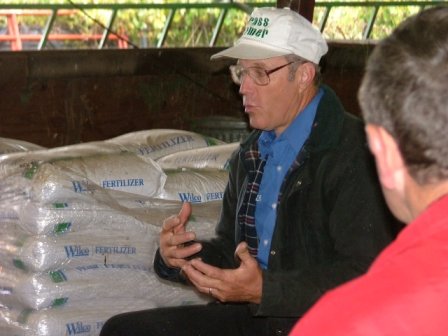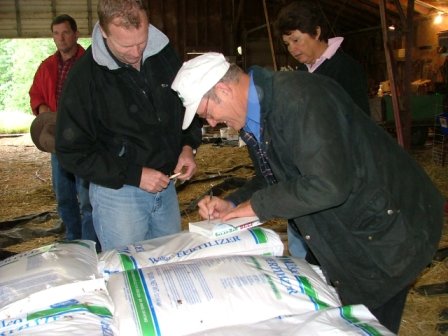The chores stopped at Warwick and Janice Bryant’s sheep farm on a rainy Tuesday in June. It wasn’t the rain that stopped them; it was a visit by a farmer from Swoope, Va. named Joel Salatin. The Bryants set up hay bales in their large open air barn to accommodate about two dozen local area farmers who wanted to meet Salatin and hear what he had to say.
 Joel Salatin speaks to visitors of Warwick and Janice Bryant's farm. Photo by Danna Webster
Joel Salatin speaks to visitors of Warwick and Janice Bryant's farm. Photo by Danna Webster
Joel Salatin has become the guru of modern day farmers. His Polyface Farm, a farm of many faces, has become a popular tour destination for Americans interested in healthy food sources. Salatin was in Washington for major speaking engagements and Erin Ewald, who has her Pierce Conservation District office in Key Center, invited him to visit the Key Peninsula. He accepted.
The weather cooperated Key Peninsula style. The rain stopped long enough for guests to hike up the quarter-mile lane to the barn, there was a torrential downpour while all were snuggled on hay bales listening to Salatin, and the rain paused long enough for everyone to return to their cars.
Salatin’s topic was grass farming but like the name of his farm, the topic took on many faces. Why grass framing? “Grass farming enjoys a cultural desire for pastoral landscaping right now. We (farmers) have something ecstatically and sentimentally desirable,” he said to the guests sitting on hay bales and looking out upon the pastoral landscape of Bryants’ sheep grazing on rich green pastures.
 Guests line up for autographs from Joel Salatin. Matt Steurer of Driftwood Ranch in Vaughn was first in line. LaLaine Wong of the Wong Family Farm waits for her turn. Photo by Danna Webster
Guests line up for autographs from Joel Salatin. Matt Steurer of Driftwood Ranch in Vaughn was first in line. LaLaine Wong of the Wong Family Farm waits for her turn. Photo by Danna Webster
Salatin first spoke about the brix of grass. Like grapes, grass reaches a natural sugar content (brix) at its peak. A high brix in grass indicates a high humus in soil, which is achieved when organic matters sweeten the soil. The farmers wants a good sweet grass for their animals’ pasture and good pasture requires good usage. Which introduced the topic of Salatin’s mob grazing technique. A mob of animals, such as cattle or chickens, are crowded into a restricted area of pasture for a given period of time and moved systematically across the acreage. The mob acts as a single organism mowing the grass, while enriching the soil.
At Polyface Farm, Salatin employs his mob grazing theory, which he says is nature’s model. Herbivores in nature mob for predator protection, moving daily onto fresh forage and away from yesterday’s droppings. His goal is to approximate nature’s template as closely as possible. When the cows rotate out of one pasture, a portable henhouse, called the Eggmobile, moves in. The laying hens free range from it, eating bugs and scratching through cattle droppings, sanitizing the pasture just like birds in nature.
Choosing the right animals based on desirable inherited traits became the next topic as Salatin discussed genetics and geography. He discouraged importing breeds from regions foreign to our habitat. He explained the reason breeds have geographic names (Shetland Ponies, Scottish Highlanders) is because over time they worked well in that region. “We need a Pierce County sheep,” he said. “It is a big mistake to bring in the wrong geographical animals, just because they are cute, in preference to the run of the mill stock from the neighbors,” he said.
Once farmers achieve successful crops and herds, their next problem is getting their product to consumers, according to Salatin. “I believe the biggest hurtle is distribution,” Salatin said as he began to describe a practice at his Polyface Farm where local farmers bring their produce to a central location and carpool it to the markets. “Distribution and marketing are collaborative based and shared at so much per pound,” he explained.
The distribution topic was particularly significant to one guest, Todd Waltermire of Oakland Bay Farm in Shelton. He has begun organizing farmers in his area into a fresh harvest-share program. Consumer members receive fresh produce from local farms on a weekly delivery basis. (Waltermire has a Webpage for information about his project atwww.oaklandbayorganicfarm.net )
After the presentation, Salatin was surrounded by guests seeking autographs. Some had become fans after reading about Salatin in Michael Pollan’s “The Omnimvore’s Delimma” .and others brought copies of Salatin’s own books such as “EVERYTHING I WANT TO DO IS ILLEGAL: War Stories from the Local Food Front,” “Holy Cows and Hog Heaven,” or” Salad Bar Beef.”
Guests drove away from the Bryants’ Kaukiki Farm enthused about farming and about the prospect for the new farmers market in Key Center. Many of them are involved with the market or with the HarvestFest Farm Tour that occurs the first Saturday in October. After Salatin’s presentation, Janice Bryant was asked if she thought the Key Peninsula farmers market is a good idea, and answered, “I think it is essential as an outlet for local farmers in the community to support each other.”
Supportive farmers working to sustain the farm lands was essential in the message Salatin delivered to the Key Peninsula.
UNDERWRITTEN BY THE FUND FOR NONPROFIT NEWS (NEWSMATCH) AT THE MIAMI FOUNDATION, THE ANGEL GUILD, ADVERTISERS, DONORS AND PEOPLE WHO SUPPORT INDEPENDENT, NONPROFIT LOCAL NEWS